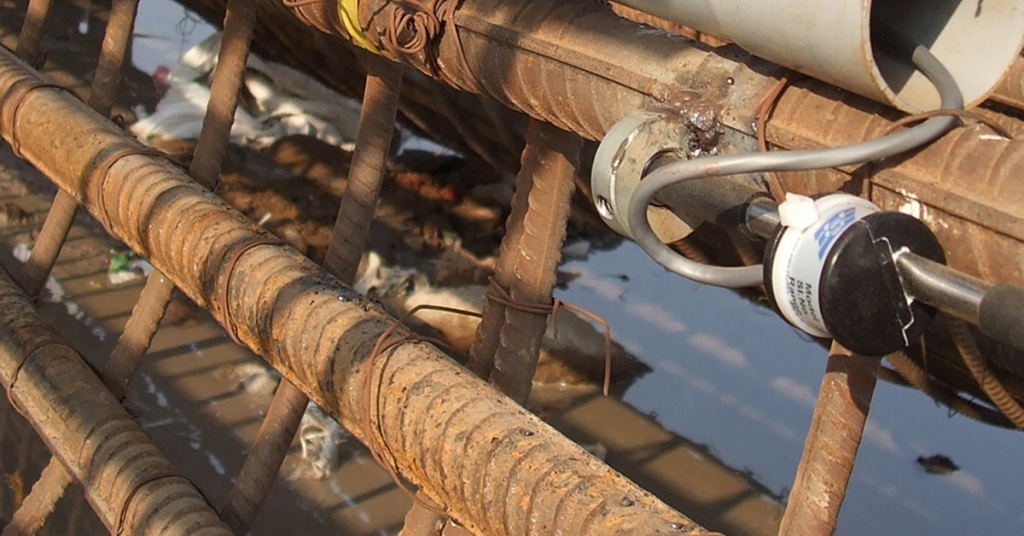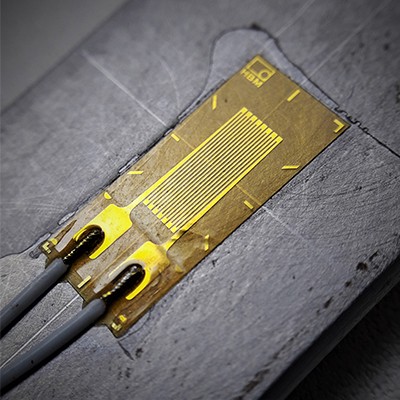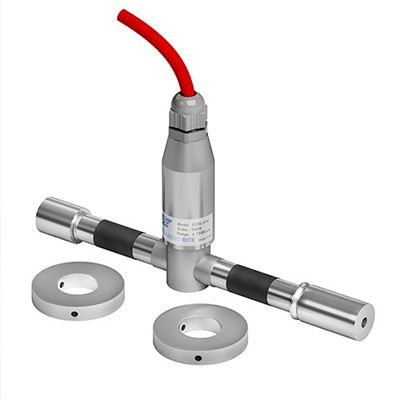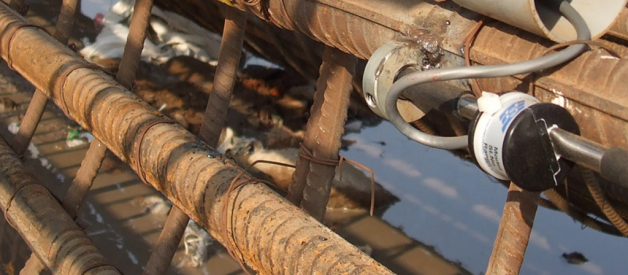July 3, 2019 | Credits: Encardio-Rite

Strain Gauges are an important geotechnical tools that measure strain in underground cavities, tunnels, buildings, concrete, masonry dams, bridges, embedment in soil/concrete. etc. The main purpose of a strain gauge is to indirectly determine stress and its variation with time, quantitatively. Change in stress is determined by multiplying the measured strain by the modulus of elasticity.
Here?s everything that you need to know about Strain Gauges. We have covered its working principles, characteristics, features, as well as, application areas.
What is a Strain Gauge?

Strain Gauge or Strain Gage was invented in 1938 by Edward E. Simmons and Arthur C. Ruge. It is one of the significant sensors used in the geotechnical field to measure the amount of strain on any structure (Dams, Buildings, Nuclear Plants, Tunnels, etc.). The resistance of a strain gauge varies with applied force and, it converts parameters such as force, pressure, tension, weight, etc. into a change in resistance that can be measured later on.
Whenever an external force is applied to an object, it tends to change its shape and size thereby, altering its resistance. The stress is the internal resisting capacity of an object while a strain is the amount of deformation experienced by it.
Any basic strain gauge consists of an insulating flexible backing that supports a metallic foil pattern. The gauge is attached to the object under stress using an adhesive. The deformation in the object causes the foil to get distorted which ultimately changes the electrical resistivity of the foil. This change in resistivity is measured by a Wheatstone bridge which is related to strain by a quantity called, Gauge Factor.
How does a strain gauge work?
A strain gauge depends on the electrical resistivity of any conductor. The resistance in any conducting device is dependent on its length as well as the cross-section area.
Suppose L1 is the original length of wire and L2 is the new length after an external force is applied on it, the strain (?) is given by the formula:
? = (L2-L1)/L1
Now, whenever an external force changes the physical parameters of an object, its electrical resistivity also changes. A strain gauge measures this deformity by using the Gauge Factor formula.
In the case of real-life monitoring, while constructing concrete structures or monuments, the load is applied at the load application point of a load cell that consists of a strain gauge underlying it. As soon as the force is exerted, the strain gauge is deformed and, this deformation causes a change in its electrical resistance which ultimately changes the output voltage.
The Gauge Factor is the sensitivity coefficient of strain gauges and, is given by the formula:
GF = [?R / (RG * ?)]
Where,
?R = Change in the resistance caused due to strain
RG = resistance of the undeformed gauge
? = Strain
The gauge factor for common metallic foil is usually a little over 2. The output voltage of the Wheatstone Bridge, SV is given by the formula:
SV = {EV x [(GF x ?)/4]}
Where,
EV is the bridge excitation voltage
The Gauge Factor of different materials is as given below:
Material
Gauge Factor
Metal foil strain gauge
2?5
Thin-film metal (e.g. constantan)
2
Single crystal silicon
-125 to + 200
Polysilicon
30
p-type Ge
102
Thick Film Resistors
100
What is the working principle of Strain Gauge
A strain gauge works on the principle of electrical conductance and its dependence on the conductor?s geometry. Whenever a conductor is stretched within the limits of its elasticity, it doesn?t break but, gets narrower and longer. Similarly, when it is compressed, it gets shorter and broader, ultimately changing its resistance.
We know, resistance is directly dependent on the length and the cross-sectional area of the conductor given by:
R= L/A
Where,
R = Resistance
L = Length
A = Cross-Sectional Area
The change in the shape and size of the conductor also alters its length and the cross-sectional area which eventually affects its resistance.
Any typical strain gauge will have a long, thin conductive strip arranged in a zig-zag pattern of parallel lines. The reason behind aligning them in a zig-zag fashion is that they don?t increase the sensitivity since the percentage change in resistance for a given strain for the entire conductive strip is the same for any single trace.
Also, a single trace is liable to overheating which would change its resistance and thus, making it difficult to measure the changes precise
How do you measure strain with a strain gauge?
As mentioned earlier, strain gauges work on the principle of the conductor?s resistance which gives you the value of Gauge Factor by the formula:
GF = [?R / (RG * ?)]
Now, in practice, the change in the strain of an object is a very small quantity which can only be measured using a Wheatstone Bridge. The Wheatstone Bridge circuit is given below.

Figure 1: Strain Gauge Circuit
A Wheatstone Bridge is a network of four resistors with an excitation voltage,Vexthat is applied across the bridge. The Wheatstone Bridge is the electrical equivalent of two parallel voltage divider circuits with R1 and R2 as one of them and R3and R4as the other one.
The output of the Wheatstone circuit is given by:
Vo = [(R3/R3+R4) ? (R2/R1+2)] * Vex
Whenever R1/ R2 = R4/ R3, the output voltage Vo is zero and the bridge is said to be balanced. Any change in the values of R1, R2, R3, and R4 will, therefore, change the output voltage. If you replace the R4 resistor with a strain gauge, even a minor change in its resistance will change the output voltage Vex which is a function of strain. The equivalent strain output and voltage output always have a relation of 2:1.
Characteristics of strain gauges
The characteristics of strain gauges are as follows:
- They are highly precise and don?t get influenced due to temperature changes. However, if they do get affected by temperature changes, a thermistor is available for temperature corrections.
- They are ideal for long distance communication as the output is an electrical signal.
- Strain Gauges require easy maintenance and have a long operating life.
- The production of strain gauges is easy because of the simple operating principle and a small number of components.
- The strain gauges are suitable for long-term installation. However, they require certain precautions while installing.
- All the strain gauges produced by Encardio-Rite are hermetically sealed and made up of stainless steel thus, waterproof.
- They are fully encapsulated for protection against handling and installation damage.
- The remote digital readout for strain gauges is also possible.
Where are strain gauges used? | What are the applications of strain gauges?
Strain gauges are extensively used in the field of geotechnical monitoring to keep a constant check on structures, dams, tunnels, and buildings so that the mishaps can be avoided well on time. The applications of strain gauges include:
Aerospace

Strain gauges are fixed to the structural load-bearing components to measure stresses along load paths for wing deflection or deformation in an aeroplane.
The strain gauges are wired into the Wheatstone Bridge circuits and, its application areas include onboard signal conditioning units, excitation power supplies, and the telemetry necessary to read in site measurements.
Cable Bridges

Instrumentation of bridges is done to verify design parameters, evaluate the performance of new technologies used in the construction of bridges, to verify and control the construction process and for subsequent performance monitoring.
Well-instrumented bridges can alert responsible authorities about approaching failure so as to initiate preventive measures. Choosing proper sensor types, technology, a measurement range and their location on the bridge is very important to optimize costs and to extract full benefits of instrumentation.
It becomes necessary to monitor the bridges regularly for any kind of deformation as it might lead to fatal accidents. Strain gauge technology is used in the real-time monitoring of huge bridges, making the inspections precise.
For example, Yamuna Bridge in Allahabad-Naini is a 630 meter cable-stayed bridge across river Yamuna. The bridge is installed with many measurement channels that sense wind speed and strain on its cables.
Rail Monitoring

Strain Gauges have a long history in the safety of rails. It is used to measure stress and strain on rails. Strain gauges measure axial tension or compression with no impact on the rails. In case of an emergency, the strain gauges can generate a warning so maintenance can be done early to minimize the impact on rail traffic.
Torque and Power Measurements in Rotating Equipment
Strain gauges can measure the torque applied by a motor, turbine, or engine to fans, generators, wheels, or propellers. You will find such types of equipment in power plants, ships, refineries, automobiles and industries.
Why are strain gauges important?
Strain gauges are extensively used in the field of geotechnical monitoring and instrumentation to constantly monitor dams, inner linings of tunnels, structures, buildings, cable-stayed bridges, and nuclear power plants to avoid mishaps and accidents in case there?s any deformity in them.
Timely actions taken can avoid accidents and loss of life due to deformities. Hence, strain gauges are important sensors in the geotechnical field.
Strain gauges are installed on these structures and then, the complete data from them is remotely retrievable through data loggers and readout units. They are considered as significant measuring equipment for ensuring productivity and safety.
Types of Strain Gauges
There are several strain gauge types based on the principle of their working viz. mechanical, optical, acoustical, pneumatic or electrical. Considering the mounting, strain gauges can be either bonded or unbonded and based on the construction, we can have foil, semiconductor, and photoelectric strain gauges.
Encardio-rite primarily deals with six different types of strain gauges:
Model EDS-11V/Hermetically Sealed Vibrating Wire Strain Gauge

The Model EDS-11V strainmeter is suitable for embedment in soil or concrete or for surface mounting by welding on steel structures. It provides significant quantitative data on the magnitude and distribution of compressive and tensile strain and its variations with time.
The Encardio-rite strain meter incorporates the latest vibrating wire technology to provide the remote digital readout of compressive and tensile strain in dams, bridges, underground cavities, sewer/metro/rail/road tunnels, mines, steel structures and other areas of application where strain measurement is required.
Long term stability is achieved by thermal and load cycling, the unique method of wire clamping by generating a vacuum of 1/1000 Torr inside the sensor by electron beam welding. This results in the effect of oxidation, moisture, environmental conditions and any ingress of water being completely eliminated.
Working Principle of Hermetically Sealed Vibrating Wire Strain Gauge
The Encardio-rite vibrating wire strain meter basically consists of a magnetic, high tensile strength stretched wire, one end of which is anchored and the other end is displaced proportionally to the variation in strain.
Any change in the strain directly affects the tension of the wire, resulting in a corresponding change in the frequency of vibration of the wire. The resonant frequency, with which the wire vibrates, is read by the readout unit. The strain is proportional to the square of the frequency and the readout unit is able to display this directly in strains.
Characteristics of Hermetically Sealed Vibrating Wire Strain Gauge
- The strain gauge is accurate, robust and low cost
- It ensures long term stability with high reliability
- It?s hermetically sealed under a vacuum of 0.001 Torr
- The strain gauge is made up of stainless steel construction
- It doesn?t require any special installation and maintenance
- A wide range of accessories are available along with this strain gauge
- A thermistor is available for temperature correction
- Remote digital readout for strain measurement
- Ease in data logging
Applications of Hermetically Sealed Vibrating Wire Strain Gauge
- Measurement and monitoring..(Read More..)


